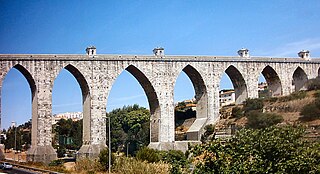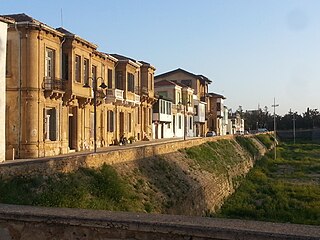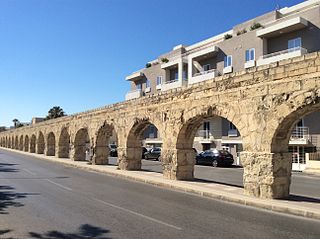
The Eyalet of Cyprus was an eyalet (province) of the Ottoman Empire made up of the island of Cyprus, which was annexed into the Empire in 1571. The Ottomans changed the way they administered Cyprus multiple times. It was a sanjak (sub-province) of the Eyalet of the Archipelago from 1670 to 1703, and again from 1784 onwards; a fief of the Grand Vizier ; and again an eyalet for the short period from 1745 to 1748.

The Aqueduct of Segovia is a Roman aqueduct in Segovia, Spain. It was built around the first century AD to channel water from springs in the mountains 17 kilometres (11 mi) away to the city's fountains, public baths and private houses, and was in use until 1973. Its elevated section, with its complete arcade of 167 arches, is one of the best-preserved Roman aqueduct bridges and the foremost symbol of Segovia, as evidenced by its presence on the city's coat of arms. The Old Town of Segovia and the aqueduct, were declared a UNESCO World Heritage Site in 1985.

The Águas Livres Aqueduct is a historic aqueduct in the city of Lisbon, Portugal. It is one of the most remarkable examples of 18th-century Portuguese engineering. The main course of the aqueduct covers 18 km, but the whole network of canals extends through nearly 58 km.

The Aqua Julia is a Roman aqueduct built in 33 BC by Agrippa under Augustus to supply the city of Rome. It was repaired and expanded by Augustus from 11–4 BC.

The AqueductofValens was a Roman aqueduct system built in the late 4th century AD, to supply Constantinople – the capital of the Eastern Roman Empire. Construction of the aqueduct began during the reign of the Roman emperor Constantius II and was completed in 373 by the Emperor Valens. The aqueduct remained in use for many centuries. It was extended and maintained by the Byzantines and the Ottomans.
Ebubekir Pasha, also referred to as Koca Bekir Pasha and Abu Bakr Pasha or Abubakr Pasha, was an Ottoman statesman. He served as Kapudan Pasha ; as governor (beylerbey) of the provinces of Egypt, Jeddah, Cyprus, and Bosnia; and as head of the Imperial Mint. He was the husband of Safiye Sultan and thus son-in-law (damat) of Sultan Mustafa II.

Notre Dame de Tyre or Our Lady of Tyre, or simply as Armenian church is a monastic church in Nicosia, Cyprus. It is located in the Arab Ahmet quarter, in Salahi Şevket Street, formerly known as Victoria Street.

The Armenian Genocide Monument in Nicosia, Cyprus, is a monument dedicated to the martyrs and the survivors of the Armenian genocide of 1915–1923. It is located within the Armenian complex on Armenia street in Acropolis, Strovolos, which contains the Armenian Prelature building, the Sourp Asdvadzadzin cathedral, the Nareg Armenian School, the marble khachkar, the bust of Archbishop Zareh Aznavorian and the statue of Gregory of Nareg.

Kamares Aqueduct, also known as the Bekir Pasha Aqueduct, is an aqueduct near Larnaca, Cyprus. Located outside the city, near the old road to Limassol, it was built starting in 1747. Tassos Mikropoulos has described it as the most prominent water supply built in Cyprus.

The Kyrenia Gate, is a gate in the Nicosia walls, in North Nicosia, Northern Cyprus. It was the gate which was used for transport to the northern areas, especially Kyrenia.

Sarayönü, officially Atatürk Square, is a square in North Nicosia. It is the centre of the Turkish part of the city and was the administrative center of the island for centuries.

Taht-el-kale is a neighbourhood, quarter of Nicosia, Cyprus and the mosque situated therein.

Arab Ahmet is a neighbourhood, quarter, mahalla or parish of Nicosia, Cyprus and the mosque situated therein. Both the quarter and the mosque are named after Arab Ahmet Pasha, one of the Turkish commanders in the Ottoman conquest of Nicosia. It is spelled Arabahmet in Turkish and Άραπ Άχμετ in Greek.

The Wignacourt Aqueduct is a 17th-century aqueduct in Malta, which was built by the Order of Saint John to carry water from springs in Dingli and Rabat to the newly built capital city Valletta. The aqueduct carried water through underground pipes and over arched viaducts across depressions in the ground.
Ayios Andreas or Tophane is a Neighbourhood, Quarter, Mahalla or Parish of Nicosia, Cyprus. In September 1945, the Ottoman name of Tophane was changed to Ayios Andreas, but there is no parish church of that name.

The Famagusta Gate is a gate in the Nicosia walls, Cyprus. It is the chief gate of the city: the Porta Giuliana, or "di sotto" of Fra Stefano Lusignano's " Chorograffia", known as Famagusta Gate in modern times. This construction, in the Venetian style has been copied from the famous Lazaretto Gate of Candia designed by Michael Sammicheli at the beginning of the 16th century, and consists of a vaulted passage through the earthwork rampart of the city with a carefully executed spherical dome, eleven metres (36') in diameter, in its centre. The passageway is large enough for two vehicles to pass, and it is lighted by a circular opening in the centre of the dome in the style of the Pantheon, Rome. On either side of this passage appear to be entrances into chambers now blocked up. The external doorway of the Porta Giuliana is a small archway in the re-entering angle or "orecchione" of the Caraffa bastion now somewhat injured by breakage of the arch stones, and the ancient doors, etc., are missing. On the inner side of the gateway, facing the town, is an imposing facade.

The Aqua Anio Vetus was an ancient Roman aqueduct, and the second oldest after the Aqua Appia.

The Caños de Carmona is a Roman aqueduct built during the first century BC to supply water from a spring in the ancient Roman city of Irippo –current Alcalá de Guadaíra– to the ancient Roman city of Hispalis –current Seville–, both in the ancient Roman province of Hispania Ulterior –current Spain–. It was later renovated and partially re-built in the twelfth century by the Almohads and it was fully operational until its demolition in 1912. Some sections survived the demolition and remain standing today.

İplik Pazarı Mosque is a mosque in the Iplik Bazar–Korkut Effendi quarter in the walled city of Nicosia, currently located in North Nicosia. It is located on İplik Pazarı Street. Its minaret is one of the very few in Cyprus to have a stone cap.

The Cairo Citadel Aqueduct or Mamluk Aqueduct is a medieval aqueduct system in Cairo, Egypt. It was first conceived and built during the Ayyubid period but was later reworked by several Mamluk sultans to expand the provision of water to the Citadel of Cairo. Although no longer functioning today, much of the aqueduct structure, including its water intake tower, still stands.




















